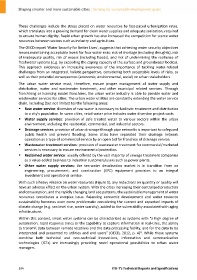Page 514 - Shaping smarter and more sustainable cities - Striving for sustainable development goals
P. 514
These challenges include the stress placed on water resources by fast‐paced urbanization rates,
which translates into a growing demand for clean water supplies and adequate sanitation, required
to ensure human dignity. Rapid urban growth has also increased the competition for scarce water
resources between sectors such as industry and agriculture.
The OECD report 'Water Security for Better Lives', suggests that achieving water security objectives
means maintaining acceptable levels for four water risks: risk of shortage (including droughts), risk
of inadequate quality, risk of excess (including floods), and risk of undermining the resilience of
freshwater systems (e.g. by exceeding the coping capacity of the surface and groundwater bodies).
This approach evidences an increasing awareness of the importance of tackling water‐related
challenges from an integrated, holistic perspective, considering both acceptable levels of risks, as
well as their potential consequences (economic, environmental, social) on urban stakeholders.
The urban water service must, therefore, ensure proper management of water supply and
distribution, water and wastewater treatment, and other municipal related services. Through
franchising or licensing model franchises, the urban water industry is able to provide water and
wastewater services for cities. The urban water utilities are constantly extending the water service
chain, including (but not limited to) the following areas:
Raw water service: diversion of raw water is necessary to facilitate treatment and distribution
to a city's population. In some cities, retail water price includes water diversion project costs.
Water supply services: provision of safe treated water to various sectors within the urban
environment, including the residential, commercial, and industrial sectors.
Drainage services: provision of urban drainage through pipe networks is important to safeguard
public health and prevent flooding. Some cities have separated their drainage network
operation as a type of commercial service by an open bid for franchise of drainage service.
Wastewater treatment services: provision of wastewater treatment for commercial/marketed
services is necessary to ensure environmental protection.
Reclaimed water service: usually offered by the vast majority of sewage treatment companies
as a value‐added business to industrial customers/users such as power plants.
Other water supply services: the sea‐water desalination market is in transition from an
engineering, procurement, and construction (EPC) equipment provision to an integral
investment and operational service.
With such a heavy reliance on water resources (Figure 1), any reductions on quantity or quality will
have an adverse effect on the urban system. With the cities increasing their centralized production
and consumption, and the rapidly changing land use patterns, the sustainable management of water
resources constitutes a complex issue. Balancing economic development and water resource
sustainability becomes even more problematic considering the current and expected impacts of
climate change (e.g. sea level rise, water scarcity), added to the vulnerability associated with aging
infrastructure.
Within this context, smart water systems can be characterized as systems with "a high degree of
automation, rapid response times or the capability to capture information in real‐time, the ability
to transmit data between remote locations and the data processing facility, and for the data to be
4
interpreted and presented to utilities and end users" (OECD, 2012, p. 4) . While these systems
combine both technical and non‐technical innovations, information and communication
technologies (ICTs) are increasingly providing novel operational possibilities to urban water
managers.
504 ITU‐T's Technical Reports and Specifications

